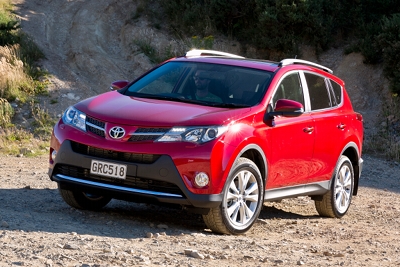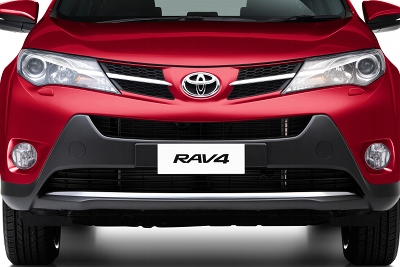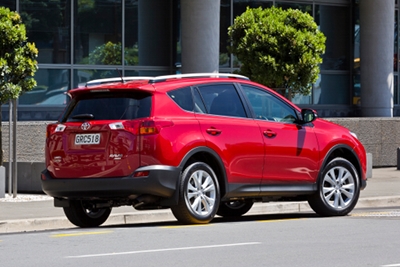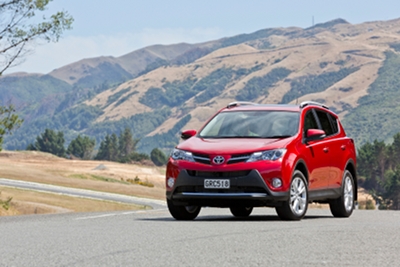The Toyota RAV4 has come a long way since its inception as the first of the small crossover SUVs based on a car platform – the Corolla to be exact. Many followed and the market for such vehicles exploded globally, but particularly here in New Zealand. The RAV4’s success was almost assured. Now Toyota launches a new, bigger RAV4 that it hopes will continue that successful run. We head to Palmerston North to try the range out.
What is it?
As stated previously, the first of the car-based SUVs that now largely dominate our roads. Based on the Corolla, the RAV4 was a revelation at the time – something that looked like a 4WD, but that also went around corners properly and didn’t try to shake your vertebrae out of whack with its ride.
As with all things in the automotive world, the RAV4 has grown considerably since its first generation and now, nineteen years since it first appeared, we have a new, bigger RAV4.
Picking up on Toyota’s new generation of “family” styling cues, the RAV4 now has more visually in common with a Corolla than it ever has before. It also shares an engine and transmission, with the 2WD models getting the same 107kW/187Nm 2.0-litre four-cylinder petrol engine and continuously variable transmission as found in the Corolla.
Two other engines are available in the RAV4 line up; a 132kW/233Nm 2.5-litre four-cylinder petrol and a 110kW/340Nm 2.2-litre four-cylinder diesel. Both engines are only available with a six-speed automatic transmission, with Toyota NZ having decided to drop the manual option altogether with the new generation car.
The range kicks off with the GX that comes standard with 17-inch steel wheels, seven airbags (including a driver’s knee bag), LED daytime running lights, cruise control, manual air conditioning, rear parking sensors, a 6.1-inch touchscreen audio system, a multi-function steering wheel, Bluetooth phone and audio connectivity and a rear tonneau cover and luggage net.
The 2WD 2.0-litre petrol CVT GX starts the range at $39,990, while the 4WD 2.5-litre auto pups this to $47,290. The diesel tops the GX range at $49,290.
The GXL comes next and adds 17-inch alloy wheels, a reversing camera, push-button start, dual zone air conditioning, rain sensing wipers, fog ights, rear privacy glass and a leather steering wheel and gear knob.
The GXL starts at $44,490 for the 2.0-litre 2WD petrol CVT. The 2.5-litre 4WD lands at $51,490, while the diesel costs $53,490.
The Limited model tops the range, and adds 18-inch alloy wheels, satellite navigation, a blind spot monitoring system, auto-levelling HID headlights, headlight washers, partial (artificial) leather seats, power adjustable, heated driver and front passenger seats and a tilt and slide moon roof.
The Limited is only available in 4WD and the 2.5-litre petrol costs $60,790, while the diesel is a hefty $62,790.
What’s it like?
To say it was like a bigger Corolla with 4WD would not be entirely fair, because it is better than that would imply, but as a general summary that works.
The inside is impressively roomy, well-designed and nicely put together. The driving position is pleasantly commanding, without being too high and there is an large amount of adjustability in the seats, particularly in height.
The dash is heavily stylised, with a distinct “cockpit” arrangement to the driving position. While the majority of the controls are well laid out and sensibly placed, there are a few ergonomic howlers, like the odd, almost hidden placement of the hill descent control button.
On the road, the RAV4 feels well-planted and confident on the tarmac. It has a confident, assured feel, while remaining impressively responsive to steering inputs. Body roll is present, but surprisingly minimal.
You are left with no doubt whatsoever that the RAV4 is predominantly a FWD vehicle, but the 4WD system is progressive and nicely calibrated.
A small off road excursion at the launch coincided with the first serious amount of rain in quite some time, so proved two things; the RAV4’s hill descent system is effective, if very abrupt, and that road tyres and clay do not mix, even with 4WD.
While we DID get stuck on one particularly slippery uphill section (We would like to stress that we were in the PASSENGER’s seat at this time, NOT doing the getting stuck…) it did serve to highlight the RAV4’s off road abilities and, more importantly, the limitations of on-road tyres in an off road situation.
The getting stuck had almost literally nothing to do with the RAV4’s off road capabilities, as it was on a relatively steep slope with a mixture of clay and grass, with very little gravel underneath. Add in the rain and it was very unlikely that whoever went up third would actually make it, especially without proper off road tyres…
This aside, the RAV4 was as capable off road as the vast majority of its owners will ever require of it, especially given it has a maximum ground clearance of just 187mm (for the 2WD and diesel variants, oddly the 2.5 4WD only has 167mm…)
What’s good about it?
While the size has increased, it is pretty much made the RAV4 a more usable and flexible proposition. Rear legroom is impressive, while luggage space is another highlight.
The boot is particularly flexible with its combination of luggage nets, dividers and storage options and the cabin is of an impressive quality.
Fuel consumption is also impressive and the diesel engine is a particular highlight of the range.
What’s not so good?
The prices of the upper spec models causes a sharp intake of breath EVERY TIME, and if you walk out of a Toyota dealership having paid $60k plus for a top model, then you must have SUCKER tattooed across your forehead in large, possibly pink letters.
The hill descent control is very abrupt in its operation and, while effective, only works in manual mode, meaning that if you leave it in drive and expect the HDC to take care of that long, slippery slope, you are in for a particularly unpleasant surprise.
First impressions?
At first glance, Toyota seems to have hit on another winner with the new RAV4. It’s distinctive Toyota family looks mark it out from the crowd without being over the top and it is impressively refined on the road, capable enough for most off it and has more interior space and improved fuel economy.
But with massively good opposition like the Mazda CX-5 and forthcoming Ford Kuga lurking around, it makes the upper price ranges of the RAV4 look a bit sick by comparison.
There probably hasn’t been a better time to be looking at buying in the small/mid-size SUV segment, but shopping around and comparing models has never been more important either. The RAV4 will suit a lot of people, but certainly not at $60k…
Specifications
Models/prices
GX 2.0 2WD CVT – $39,990
GXL 2.0 2WD CVT – $44,490
GX 2.5 4WD auto – $47,290
GX 2.2d 4WD auto – $49, 290
GXL 2.5 4WD auto – $51,490
GXL 2.2d 4WD auto – $53,490
LTD 2.5 4WD auto – $60,790
LTD 2.2d 4WD auto – $62,790
Powertrain
2.0-litre inline four-cylinder petrol producing 107kW/187Nm; continuously variable transmission; front-wheel drive, 2.2-litre inline four-cylinder diesel producing 110kW/340Nm; six-speed automatic transmission; four-wheel drive, 2.5-litre inline four-cylinder petrol producing 132kW/233Nm; six-speed automatic transmission; four-wheel drive
Fuel consumption: 7.4l/100km (2.0), 6.5l/100km (2.2d), 8.5l/100km (2.5)
CO2 emissions: 173g/km (2.0), 172g/km (2.2d), 198g/km (2.5)
Safety
ANCAP/EuroNCAP rating: 5 star
Air bags: 7
Stability control: yes
Lap/diagonal belts: 5







You must be logged in to post a comment.